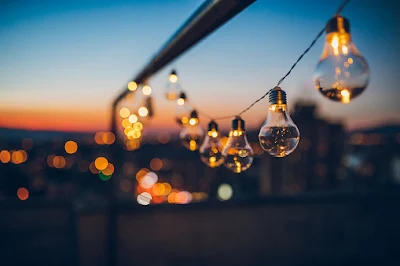How Light Works
What is light scientifically?
How Light Works - Physics
How Light Works - Technology
For hundred of years, the only light we had was from oil lamps, candles, and gas lamps. Then electricity was invented. The discovery of electricity sparked a race to design electric lights that were small and safe enough to be used at home. Englishman Joseph Swan and American Thomas Edison hit on the same bright idea. They teamed up to sell their inventions, and in 1881, the first commercial lightbulbs were produced. People were no longer limited to candlelight to see in the dark. For the first time, doctors, craftspeople, and factory workers could see well enough to work at night. Streetlights made traveling safer. Miners no longer carried dangerous naked flames. Within 25 years, millions of homes were lit by electric lamps.
How Light Bulbs Work:
Basic Traditional light bulbs contain a small coil, or filament, made from tungsten, a strong metal. Wires heat up as electricity passes through them. If they get hot enough, they glow as electrical energy is changed into light as well as heat. Long, thin coiled wires produce the brightest light. Modern filaments have coils so small, they can be seen only with a microscope. For a 60-watt 120-volt lamp, the uncoiled length of the tungsten filament is usually 580 millimeters (22.8 in), and the filament diameter is 0.046 millimeters
How Energy Saving Bulbs Work:
Energy-saving light bulbs don’t have a filament. Instead, they use electrodes when an electric current is passed through a tube containing a gas called argon and a tiny amount of mercury vapor. These energize the gases inside the tube and make them glow. This process then generates ultraviolet light which is invisible but which excites the molecules in a fluorescent coating — called phosphor — on the inside of the tube, which then emits visible light. These lights are much cooler than traditional bulbs, last longer, and use less energy. Although cheap to produce, modern lightbulbs convert just 4–6 percent of their electricity supply into light. The rest is wasted as heat.
How LEDs Work:
Small and bright Very tiny light bulbs called LEDs (light-emitting diodes) are used in all kinds of electronic equipment, such as stereos, computers, signs and outdoor display screens. When the electricity passes through the diode(which is made of material – usually aluminum-gallium-arsenide AlGaAs), it emits electromagnetic particles called photons which produce the light we see in our rooms and on our streets.
Now as they are more affordable and are likely to be found in most places, from homes to office buildings. Because they turn up to 95% of their energy into light, they are far more efficient than traditional bulbs and last much longer, according to the University of Wisconsin. They give off a very bright light and come in lots of different colors.
How Lasers Work:
A substance that when excited by energy emits light in all directions is called lasing material which can be a gas, liquid, or semi-conducting material. The optical cavity is used to reflect light from the lasing medium back into itself. It typically consists of two mirrors, one at each end of the lasing medium. As the light is bounced between the two mirrors, it increases in strength, resulting in amplification of the energy from the excitation mechanism in the form of light. The output coupler of a laser is usually a partially transparent mirror on one end of the lasing medium that allows some of the light to leave the optical cavity to be used for the production of the laser beam.
More in depth working is available at how laser works scientifically.
This principle makes laser beams so intense they can cut through metal. Lasers are used in surgery, CD players, surveying, and industry. Lasers are used for many types of surgery. The heat of the light is used to burn through tissue without cutting it with a scalpel. Lasers are also used to shatter kidney stones, and shape cavities for fillings in dentistry.
Frequently Asked Questions on Light
How light works in space?
Light is an electromagnetic wave which does not require any medium to travel, that's why it can travel in space which is vacuum.
What are Properties of light?
The light has wave-particle duality which means it travels like wave at the same time cannot pass through translucent objects just like particles.
How does light help you see?
When light hits the retina (a light-sensitive layer of tissue at the back of the eye), special cells called photoreceptors turn the light into electrical signals. These electrical signals travel from the retina through the optic nerve to the brain. Then the brain turns the signals into the images you see.
-------------------------------------------------------------------
Related articles:
How Fireworks Work - How It Works
3D Holograms - How It Works
Fingerprint Scanners - How It Works
VPN - How It Works
QR Code - How It Works
-------------------------------------------------------------------






